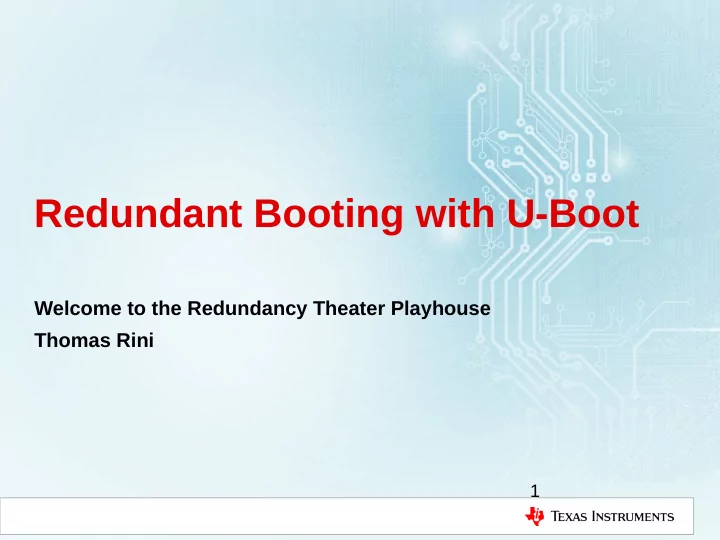

Redundant Booting with U-Boot Welcome to the Redundancy Theater Playhouse Thomas Rini 1
2 Overview • Historically how redundancy has been developed and implemented • What we have today – And have had for a while • What we hope to have soon • Sample use cases – Deployed product – Developers • Example
3 Historically... • One-off custom creations • Hacks to U-Boot • And sometimes, working with upstream and leveraging existing features
4 Features Available Now (v2014.10) • Redundant U-Boot environment • Hardware Watchdogs • Boot counting Requires a “good” location to work with – • Cryptographic image signature checking Software only, currently – • TPM (Trusted Platform Module) support • “Falcon Mode”, aka SPL boots OS Some of this is relatively new, much of it is not. We're working to address needs and enhance support, as developers come forward.
5 How it looks
6 Features In Progress • Linux Kernel side of Boot counting Have to clear the counter once the system decides it's up and – stable Work in Progress: http://goo.gl/ES0tYf – • Hardware / ROM Cryptographic image signature checking • “Falcon Mode” enhancements • SPL / Bootcount enhancements using environment – Work in Progress: https://github.com/trini/u-boot/tree/v2014.10- plus-spl-bootcount • More FS support Read from extN not just FAT –
7 Features that have been talked about • Wider environment use in Falcon Mode Today “FAT” supports environment saying what to load, but not – “raw” modes • zImage support and/or FIT image support – Today only legacy uImages are supported Both of these would require additional work to know where to put – the payloads (in some cases) • Integrate altbootcmd into Falcon Mode Today when bootcount is exceeded we fall back to full U-Boot, but – in some cases we may not need to.
8 Sample Use Cases: Deployed Products • ROM provides a level of security and redundancy • SPL OS boot provides quick path into the Linux kernel • Redundant environment is consulted for where to find what to boot, how many times to try • A fail-safe alternative exists as backup (failed upgrades, etc) • Watchdog is enabled to reset the board when things have gone bad • Images are cryptographically signed • A TPM is enabled to allow for only trusted upgrades to happen
9 Sample Use Cases: Developer • SPL OS boot enabled, environment consulted for what Linux kernel to be booting and testing • Watchdog enabled, relatively short timeout set Catch failure quicker – • Bootlimit is set low, just 1 or 2 Again, catch failure quicker – • Environment again points to a known working backup image to use, for when things fail • fw_setenv in Linux to point at new test images / etc Development cycle improved, fallback available without external hardware.
1 0 Example • BeagleBone Black Watchdog Support – SPL OS boot enabled – Bootlimit is set, clearable from the kernel – Persistent Environment (redundant) – ● fw_setenv/getenv supports this
Recommend
More recommend